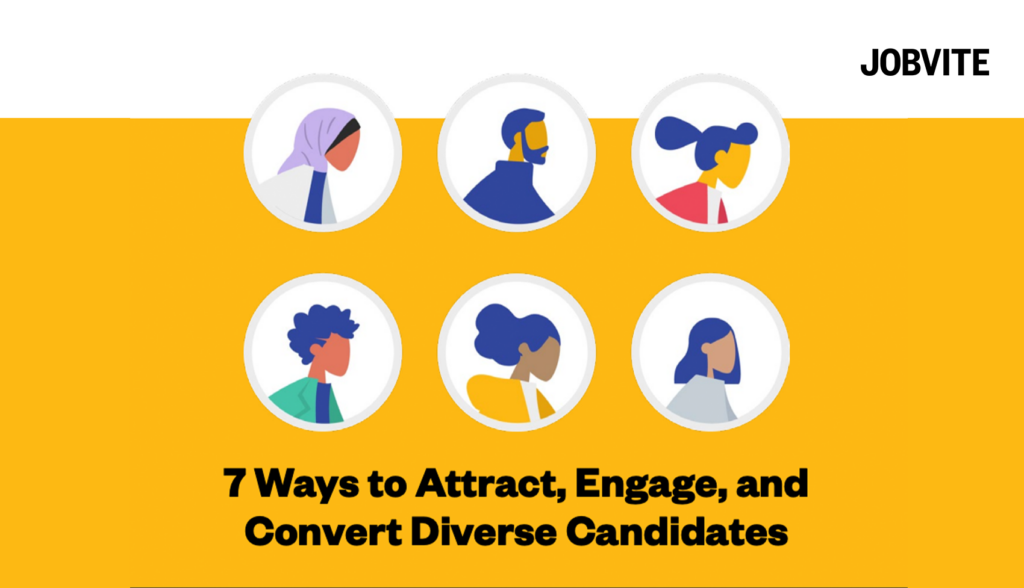
Building a truly diverse, equitable, and inclusive workplace is an ongoing endeavor for enterprises today. It’s far easier to realize this goal, however, when dedicated DEI initiatives are developed by leadership, human resources, talent acquisition, and hiring managers — and leverage employee input.
Whether you’re a CHRO, talent leader, recruiter, or other business stakeholder, you can play a pivotal role in ensuring your org attracts and retains the diverse talent it needs to thrive.
The trick is knowing how to get your first DEI initiative in the workplace up and running.
5 tips to kickstart your first DEI initiative
The good news is it’s not a one-person task. Rather, everyone interested in creating a safe and more inclusive work environment — from C-suite members to entry-level employees — can work in tandem to establish goals, execute on the agreed-upon plan, and assess success over time.
Here are five best practices to follow when establishing your initial DEI initiatives.
1) Set DEI goals and identify underrepresented groups
To begin, examine your current workforce composition and identify underrepresented groups. This will enable you to set meaningful DEI goals that reflect the specific needs of your org.
For example, you might choose targets relating to increased gender diversity in leadership positions or improved representation of people from ethnic and other minority backgrounds.
Keep in mind that building a diversity recruiting and hiring process is a long-term game. Keep your goals realistic yet ambitious to make truly meaningful progress.
If one of your goals is to hire 50% more black female engineers, assess your talent database to gauge existing prospects that align with this particular demographic. If the total number of these candidates is low, that means switching up sourcing to more diverse communities (online and offline) is likely your first step to achieve said goal.
As for existing diverse members of your workforce, empower these employees by helping them form employee resource groups (ERGs): communities where they can meet with similar backgrounds and experiences can share ideas and advocate for DEI goals.
Working with your DEI committee and employees with interest to create these groups can provide valuable feedback, insights, and ideas to drive diversity within the org and contribute to an inclusive company culture.

2) Engage stakeholders to incorporate them in decision-making
To ensure the success of your DEI initiatives, it’s essential to involve key stakeholders from across the org. This includes not only HR pros and recruiters, but also senior leaders, managers, and entry- and mid-level employees.
Each of these individuals can all play a vital role in championing diversity and inclusion in the workplace by bringing their own unique views, opinions, and ideas.
Set up regular chats so everyone involved in your DEI initiatives can discuss the key objectives they want to realize with DEI-related programs.
This can range from more equitable advancement opportunities, the intro of mentorship programs, or simply greater representation of historically marginalized groups.
Just ensure that your C-suite is not only committed to seeing each of these respective DEI initiates through, but also that they are visible and vocal in driving these efforts.
About three-quarters (77%) of “leaders” in terms of DEI program success have visible support from execs, a recent Harvard Business Review and SHRM survey found. That compares to just one-third (34%) of DEI “laggards.”
3) Modify your hiring practices to better reach diverse candidates
Transform your hiring practices to remove barriers faced by diverse candidates. This might involve using more inclusive language in job descriptions, offering flexible working arrangements, or introducing blind recruitment to minimize unconscious bias.
Also, build relationships with community orgs to tap into underrepresented groups and reach out to professional networks and social media groups that cater to diverse demographics.
Attracting and retaining diverse talent requires altering your recruitment strategies from a long-term perspective. Diversifying job boards, partnering with diversity-focused entities, and showcasing company culture through public-facing channels can help in reaching out to diverse candidates.
4) Implement dedicated DEI training and inclusion programs
Diversity training is a crucial element of any effective DEI strategy, helping employees to understand and challenge any ingrained prejudices they might hold. However, it’s essential that this training is engaging, interactive, and tailored to the specific needs of your workforce.
Also, consider introducing targeted interventions to support employees from underrepresented groups, such as mentoring, coaching, and leadership development programs.
Specific topics to cover in your diversity training as part of your DEI initiative include educating your workforce about unconscious bias, micro-aggressions, and inclusive language.

5) Measure the success of your DEI efforts
“One of the most important aspects of creating inclusive organizations is about measurement,” Evolution Managing Partner Stuart McCalla told CIO. “Numbers don’t lie.”
As with any large-scale undertaking, it’s essential to measure the success of your DEI initiatives to ensure they have a meaningful (and the intended) impact.
Track your DEI efforts by gathering and analyzing data on your org’s core diversity metrics in a centralized location. Then, use this data to set measurable milestones and evaluate progress over time.
Key metrics worth monitoring include:
Demographics (including by department)
Collect data on race, ethnicity, gender identity, sexual orientation, age, and disability status. This will help you identify any gaps with building a more diverse workforce and help you prioritize focus areas for your DEI initiatives. To gauge representation ask:
- What is the demographic makeup of this in leadership positions?
- Do certain teams lack i diversity (in general or a specific group)?
- Are sourcers reaching diverse populations of qualified candidates?
- How many diverse prospects advance far in our overall pipeline?
Tracking representation data will help you pinpoint areas that need improvement.
Employee engagement and satisfaction
A key factor in retention is ensuring all employees are satisfied with their jobs and managers and highly engaged in the company culture. A sense of belonging and purpose goes a long way in retaining top-performing employees.
With that in mind, survey your workforce regularly to gauge their perceptions of your DEI initiatives.
Ask questions about the inclusiveness of your workplace culture and any experiences they have had discrimination or bias. Then, use this feedback to fine-tune your DEI efforts and make sure that they are resonating with your employees. Inclusivity is about more than just numbers.
At the end of the day, each DEI initiative you enact is about creating a culture of psychological safety in which every employee feels valued, respected, and heard.
Routinely securing feedback from employees can provide valuable insight into the effectiveness of your distinct diversity, equity, and inclusion-centric programs.
Career mobility and advancement
Growth opportunities and upward mobility are critical components of an inclusive workplace. Scrutinize data tied to promotions and pay increases across demographics to ensure that every worker at your org has equal opportunities for professional development and advancement.
Pay equity is crucial for ensuring all employees are compensated fairly. Tracking this metric monthly can tell you if your org is meeting its goals when it comes to providing equal pay for equal work.
Unfortunately, disparities in pay for minority groups still exist, even in the most well-intentioned companies. Thus, placing an emphasis on improving pay equity on an ongoing basis must a top priority.
A major focal point of many DEI initiatives today is to improve diversity hiring. Learn how your talent team can better source, engage, and hire diverse candidates with Jobvite.





